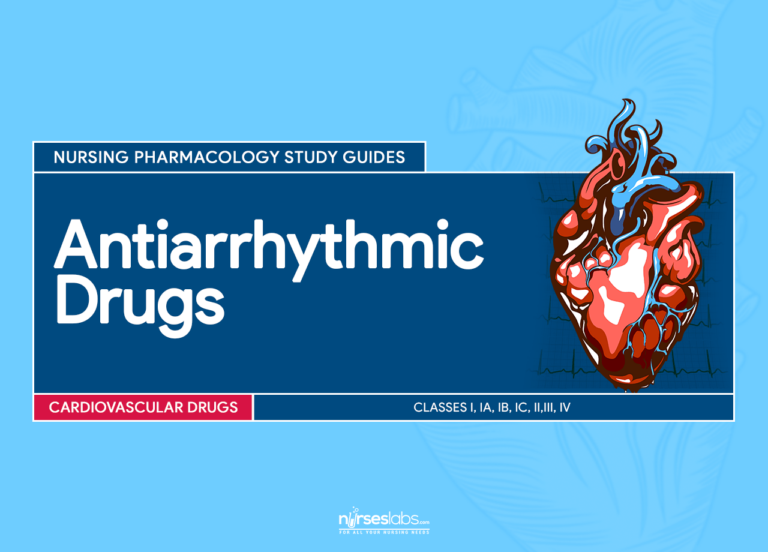Antiarrhythmics address arrhythmia by altering cells’ automaticity and conductivity.
- All cells in the heart are capable of undergoing spontaneous contractions (automaticity). Therefore, these cells are capable of generating excitatory impulses.
- Disruptions in the conduction of these impulses affect contractility of the heart as well as the volume of blood pumped by the heart each minute (cardiac output).
- Arrhythmia is the term applied for disruptions that interfere with generation of impulses and conduction of these impulses to the myocardium.
Table of Contents
- Antiarrhythmic: Generic and Brand Names
- Disease Spotlight: Arrhythmias
- Class I antiarrhythmics
- Class II antiarrhythmics
- Class III antiarrhythmics
- Class IV antiarrhythmics
- Nursing Considerations for Antiarrhythmics
- Practice Quiz: Antiarrhythmic Drugs
- Recommended Resources
- See Also
- References and Sources
Antiarrhythmic: Generic and Brand Names
Here is a table of commonly encountered antiarrhythmic drugs, their generic names, and brand names:
- Class I Antiarrhythmics
- Class IA
- disopyramide (Norpace)
- procainamide (Pronestyl)
- quinidine (Quinaglute, Quinidex)
- Class IB
- lidocaine (Xylocaine)
- mexiletine (Mexilitil)
- Class IC
- flecainide (Tambocor)
- propafenone (Rythmol)
- Class IA
- Class II Antiarrhtyhmics
- acebutolol (Sectral)
- esmolol (Brevibloc)
- propranolol (inderal)
- Class III Antiarrhythmics
- ibutilide (Corvert)
- sotalol (Betapace)
- Class IV Antiarrhythmics
- verapamil (Calan, Covera-HS)
- Other antiarrhthmics
- adenosine (Adenocard)
- digoxin (Lanoxin)
- dronedarone (Multaq)
Disease Spotlight: Arrhythmias
Arrhythmias (also called dysrhythmias) involve changes in the automaticity and conductivity of the heart cells.
To better understand this condition, there are two concepts vital to be mastered: conductivity and automaticity.
Conductivity: is the property of the heart cells to transmit spontaneous impulses starting from the sinoatrial (SA) node, activating all parts of the heart muscle almost spontaneously. Conductivity is the basis of cardiac contraction and relaxation, allowing the heart to beat. Different areas of the specialized conductive system include:
- SA node – impulse generation of 60-100 impulses per minute
- AV node – 40-50 impulses per minute
- Ventricular muscle cells – 10-20 impulses per minute
Automaticity: is the property of the heart cells to undergo spontaneous depolarization during relaxation. This is because at this point, potassium flows out of the cell while sodium moves inside: the condition necessary to produce an action potential. Here are the five phases of action potential:
- Phase 0 – depolarization phase; stage in which cell reaches point of stimulation. This phase is characterized by open sodium gates and sodium ions rushing towards the cell leading to action potential. There is absence of charge difference between the outside and the inside of the membrane.
- Phase 1 – a very short period wherein concentration of sodium equalizes inside and outside of the cell
- Phase 2 – plateau phase; stage in which cell is trying to go back to its resting stage (repolarization). The cell becomes less permeable to sodium, potassium begins to leave the cell, and calcium starts to enter the cell.
- Phase 3 – rapid repolarization phase; stage in which the sodium gates are closed and potassium flows out of the cell.
- Phase 4 – resting phase; stage in which sodium-potassium pump restores the cell’s resting membrane potential in preparation for the next action potential.
Types of arrhythmias
Depending on factors causing them, here are different types of arrhythmias:
- Changes in rate: tachycardia, bradycardia
- Stimulation from ectopic focus: premature atrial contractions (PACs), premature ventricular contractions (PVCs), atrial flutter and/or fibrillation (AF), ventricular fibrillation
- Alterations in conduction through the muscle: heart blocks, bundle branch block
- It can be triggered by the following: electrolyte disturbances, decreased oxygen supply to the cells, structural damage of the conduction system, drug effects, acidosis, and lactic acid accumulation.
Class I antiarrhythmics
- This class blocks sodium channels in the cell membrane during action potential. Subgroup under this class is based on their mechanism in blocking sodium channels.
- These class are local anesthetics and membrane-stabilizing agents because of their ability to bind more quickly to sodium channels.
Therapeutic Action
- Class I antiarrhythmics stabilize cell membrane by depressing phase 0 of action potential. They bind to sodium channels and change the duration of action potential of the cells.
- Class Ia drugs depress phase 0 and prolong duration of action potential.
- Class Ib drugs somewhat depress phase 0 and shorten duration of action potential.
- Class Ic drugs markedly depress phase 0 and extremely slows conduction but has little effect on the duration of action potential.
Indications
- Primarily indicated for decreasing workload of the heart and relieving HF
- Digoxin is especially indicated for atrial flutter, atrial fibrillation, and paroxysmal atrial tachycardia.
Children
- Antiarrhythmics are not often used for this age group
Adults
- Usually indicated for emergency cases.
- Evaluation of drug regimen should be done carefully and regularly to ensure effectiveness and patient safety.
- Drug safety for pregnant women not established.
- This drug can enter breast milk and has been associated with various side-effects.
- Antiarrhythmics I, III, and IV are strictly prohibited to lactating women.
Older adults
- They are more susceptible to drug toxicity because of underlying conditions that would interfere with metabolism and excretion of drug.
- Renal and hepatic function should always be monitored.
Pharmacokinetics
| Route | Onset | Peak | Duration |
| IM | 5-10 min | 5-15 min | 2 h |
| IV | Immediate | Immediate | 10-20 min |
| T1/2: 10 min, then 1.5-3 h Metabolism: liver Excretion: urine |
Contraindications and Cautions
- Allergy to Class I antiarrhythmics. Prevent severe hypersensitivity reactions.
- Bradycardia, heart block. Unless an artificial pacemaker is in place, the conduction-altering effect of drug can lead to total heart block.
- HF, hypotension, shock. Exacerbated by effects of drug on action potential.
- Electrolyte imbalance. Can alter drug effectiveness
- Renal, hepatic dysfunction. Interfere with drug bioavailability and excretion
- Pregnancy and lactation. Can cause potential adverse effects to the fetus or neonate.
Adverse Effects
- CNS: dizziness, drowsiness, fatigue, twitching, mouth numbness, slurred speech, vision changes, tremors
- CV: arrhythmias, hypotension, vasodilation, potential for cardiac arrest
- Respiratory: respiratory depression
- Hema: bone marrow depression
- EENT: rash, hypersensitivity reactions, hair loss
Interactions
- Digoxin, beta-blockers: increased risk for developing arrhythmias
- Quinidine with digoxin: quinidine competes with digoxin at renal transport sites so it can increase chances of developing digoxin toxicity
- Cimetidine: increased Class Ia toxicity
- Anticoagulants: increased risk of bleeding
Class II antiarrhythmics
- This class interferes with action potential by blocking beta receptors in the heart and kidneys. This, in turn, blocks phase 4 of action potential.
- Class II antiarrhythmics are beta-adrenergic blockers.
Therapeutic Action
- Class II antiarrhythmics engage in competitive inhibition of beta receptors specifically found in the heart and kidneys. For this reason, there is decreased in heart rate, excitability, and cardiac output. Conduction through AV node also slows down. In the kidneys, release of renin is decreased.
- These effects decrease blood pressure and the stabilize the highly-excitable heart. As a result, workload of the heart is lessened.
Indications
- This class is specifically indicated for treatment of supraventricular tachycardia and premature ventricular contractions (PVCs).
- Children: antiarrhythmics are not often used for this age group
- Adults: usually indicated for emergency cases. Evaluation of drug regimen should be done carefully and regularly to ensure effectiveness and patient safety. Drug safety for pregnant women not established. This drug can enter breast milk and has been associated with various side-effects. Antiarrhythmics I, III, and IV are strictly prohibited to lactating women.
- Older adults: are more susceptible to drug toxicity because of underlying conditions that would interfere with metabolism and excretion of drug. Renal and hepatic function should always be monitored.
Pharmacokinetics
| Route | Onset | Peak | Duration |
| Oral | 20-30 min | 60-90 min | 6-12 h |
| IV | Immediate | 1 min | 4-6 h |
| T1/2: 3-5 h Metabolism: liver Excretion: urine |
Contraindications and Cautions
- Sinus bradycardia (<45 beats per minute), heart block. Exacerbated by the therapeutic effects of the drug.
- HF, cardiogenic shock, asthma, respiratory depression. Exacerbated by blocking beta receptors.
- Pregnancy and lactation. Can cause potential adverse effects to the fetus or neonate.
- Diabetes, thyroid dysfunction. Altered by blockade of beta-receptors
- Renal, hepatic dysfunction. Interfere with bioavailability and excretion of drugs.
Adverse Effects
- CNS: dizziness, fatigue, dreams, insomnia
- CV: arrhythmias, hypotension, bradycardia, AV blocks, alteration in peripheral perfusion
- Respiratory: bronchospasm, dyspnea
- GI: anorexia, diarrhea, constipation, nausea, vomiting
- Other: loss of libido, decreased tolerance to exercise, alterations in blood glucose level
Interactions
- Verapamil: increased adverse drug effects
- Insulin: increased hypoglycemia
Class III antiarrhythmics
- This class prolongs and slows down the outward movement of potassium during phase 3 of action potential. These drugs act directly on the heart muscles to prolong repolarization and refractory period.
- All of these drugs are proarrhythmic and have the possibility of inducing arrhythmias.
Therapeutic Action
- Class III antiarrhythmics’ ability to prolong refractory period and repolarization increases the threshold for ventricular fibrillation.
- These are used to treat life-threatening arrhythmias for which no other drugs have been effective.
- This class can also act on peripheral tissues to decrease peripheral resistance.
Indications
- Amiodarone is the drug of choice for ventricular fibrillation and pulseless ventricular tachycardia.
- Children: antiarrhythmics are not often used for this age group
- Adults: usually indicated for emergency cases. Evaluation of drug regimen should be done carefully and regularly to ensure effectiveness and patient safety. Drug safety for pregnant women not established. This drug can enter breast milk and has been associated with various side-effects. Antiarrhythmics I, III, and IV are strictly prohibited to lactating women.
- Older adults: are more susceptible to drug toxicity because of underlying conditions that would interfere with metabolism and excretion of drug. Renal and hepatic function should always be monitored.
Pharmacokinetics
| Route | Onset | Peak | Duration |
| Oral | 2-3 d | 3-7 h | 6-8 h |
| IV | Immediate | 20 min | Infusion |
| T1/2: 10 d Metabolism: liver Excretion: urine |
Contraindications and Cautions
- AV Block. Ibutilide and dofetilide exacerbate this health condition.
- Renal, hepatic dysfunction. Interfere with bioavailability and excretion of drugs.
- Shock, hypotension, respiratory depression, prolonged QT interval. Depressed action potentials can worsen these health problems.
Adverse Effects
- CNS: weakness, dizziness
- CV: arrhythmias, HF
- GI: nausea, vomiting, GI distress
- Amiodarone is associated with liver toxicity, ocular abnormalities, and very serious cardiac arrhythmias.
Interactions
- Digoxin, quinidine: increased toxic drug effects
- Antihistamines, phenothiazines, tricyclic antidepressants: increased risk of proarrhythmias
- Dofetilide combined with ketoconazole, verapamil, cimetidine: increased risk for adverse drug effects
- Sotalol combined with antacids, NSAIDs, and aspirin: loss of effectiveness of sotalol
Class IV antiarrhythmics
- Include two calcium-channel blockers, namely: diltiazem and verapamil.
- This class blocks the movement of calcium towards the cell membrane.
Therapeutic Action
- Class IV antiarrhythmics depress action potential generation and slows down phases 1 and 2 of action potential. This action slows down both conduction and automaticity.
Indications
- Other uses of diltiazem and verapamil include treatment for hypertension and angina.
- Children: antiarrhythmics are not often used for this age group
- Adults: usually indicated for emergency cases. Evaluation of drug regimen should be done carefully and regularly to ensure effectiveness and patient safety. Drug safety for pregnant women not established. This drug can enter breast milk and has been associated with various side-effects. Antiarrhythmics I, III, and IV are strictly prohibited to lactating women.
- Older adults: are more susceptible to drug toxicity because of underlying conditions that would interfere with metabolism and excretion of drug. Renal and hepatic function should always be monitored.
Pharmacokinetics
| Route | Onset | Peak | Duration |
| Oral | 30-60 min | 2-3 h | 6-8 h |
| IV | Immediate | 2-3 min | Unknown |
| T1/2: 3.5-6 h Metabolism: liver Excretion: urine |
Contraindications and Cautions
- Allergy to calcium-channel blockers. Prevent hypersensitivity reactions.
- Heart block (sick sinus syndrome). Unless an artificial pacemaker is in place, heart blocks can be exacerbated by the effects of the drug.
- HF, hypotension. Exacerbated by hypotensive effect of the drug.
- Pregnancy, lactation. Potential adverse effects to neonate or fetus.
- Renal, hepatic dysfunction. Interfere with bioavailability and excretion of drugs.
Adverse Effects
- CNS: weakness, dizziness, fatigue, depression, headache
- CV: hypotension, shock, edema, HF, arrhythmia
- GI: nausea, vomiting, GI distress
Interactions
- Verapamil with beta-blockers: increased risk of cardiac depression
- Digoxin: additive slowing of AV node conduction
- Atracurium, pancuronium, vecuronium: increased respiratory depression
- Increased risk of cardiac depression if IV preparation of these drugs were given 48 hours within administration of IV beta-adrenergic blockers.
- Diltiazem can increase serum level of cyclosporine.
Nursing Considerations for Antiarrhythmics
Here are important nursing considerations when administering antiarrhythmics.
Nursing Assessment
These are the important things the nurse should include in conducting assessment, history taking, and examination:
- Assess for the mentioned contraindications to this drug (e.g. renal dysfunction, heart blocks, hypersensitivity, etc.) to prevent potential adverse effects.
- Conduct thorough physical assessment before beginning drug therapy to establish baseline status, determine effectivity of therapy, and evaluate potential adverse effects.
- Assess patient’s neurological status to determine potential CNS drug effects.
- Assess cardiac status closely (e.g. blood pressure, heart rate and rhythm, heart sounds, ec.) to determine whether change in drug dose is imperative.
- Monitor respiratory rate, rhythm, and depth to assess for respiratory depression and detect changes associated with development of HF.
- Monitor laboratory test results including complete blood count, renal and liver function tests to determine the need for possible change in dose and identify toxic effects.
Nursing Diagnoses
Here are some of the nursing diagnoses that can be formulated in the use of this drug for therapy:
- Decreased cardiac output related to cardiac effects of the drug
- Ineffective tissue perfusion related to decreased blood flow to different parts of the body
- Altered sensory perception related to CNS drug effects
- Risk for injury related to weakness and dizziness
Implementation with Rationale
These are vital nursing interventions done in patients who are taking antiarrhythmics:
- Titrate the dose to the smallest amount enough to manage arrhythmia to decrease the risk of drug toxicity.
- Monitor cardiac rhythm closely to detect potentially serious adverse effects and to evaluate drug effectiveness.
- Provide comfort and safety measures (e.g. raising side rails, adequate room lighting, noise control) to help patient tolerate drug effects.
- Ensure maintenance of emergency drugs and equipment at bedside to promote prompt treatment in cases of severe toxicity.
- Educate patient on drug therapy including drug name, its indication, and adverse effects to watch out for to enhance patient understanding on drug therapy and thereby promote adherence to drug regimen.
Evaluation
Here are aspects of care that should be evaluated to determine effectiveness of drug therapy:
- Monitor patient response to therapy through assessment of cardiac output and rhythm.
- Monitor for adverse effects (e.g. sedation, respiratory depression, CNS effects).
- Evaluate patient understanding on drug therapy by asking patient to name the drug, its indication, and adverse effects to watch for.
- Monitor patient compliance to drug therapy.
Practice Quiz: Antiarrhythmic Drugs
Alright, quiz time! Just how much you’ve learned from our study guide about antiarrhythmic drugs? Take our 7-item NCLEX style quiz below and find out!
1. The phase of cardiac muscle cell action potential characterized by calcium entering the cell and potassium leaving the cell.
A. Phase 1
B. Phase 2
C. Phase 3
D. Phase 4
2. Beta-adrenergic blockers belong to which class of antiarrhythmics?
A. Class Ia
B. Class Ib
C. Class II
D. Class IV
3. Which class of antiarrhythmics blocks potassium channels?
A. Class Ia
B. Class IV
C. Class Ib
D. Class III
4. This is the preferred antiarrhythmic in Advanced Cardiac Life Support protocol.
A. ibutilide (Corvert)
B. propranolol (Inderal)
C. procainamide (Pronestyl)
D. amiodarone (Cordarone)
5. What is the difference between Class Ia and Ib antiarrhythmics?
A. Ia depresses phase 0 and Ib depressed phase I.
B. Ia shortens the duration of action potential and Ib prolongs the duration of action potential.
C. Ia prolongs the duration of action potential and Ib shortens the duration of action potential.
D. Ia extremely slows down conduction and Ib has no effect on conduction.
6. A patient who is receiving quinidine should avoid the following foods, except:
A. skim milk
B. broccoli
C. Both A and B
D. none of the above
7. The drug of choice for treatment of supraventricular tachycardia associated with Wolff-Parkinson-White syndrome.
A. adenosine
B. verapamil
C. digoxin
D. lidocaine
Answers and Rationale
1. Answer: B. Phase 2.
It is also called as plateau stage. Calcium enters the cell and potassium leaves it as it becomes less permeable to sodium. Phase 1 is when sodium level becomes equal inside and outside the cell. Phase 3 is also called rapid repolarization stage, where sodium gates are already closed and potassium flows out of the cell. Phase 4 occurs when the cell comes to rest.
2. Answer: C. Class II.
They depress phase 4 of action potential. Some examples include acebutolol, propranolol, and esmolol.
3. Answer: D. Class III.
By blocking potassium channels, class III antiarrhythmics are able to prolong phase 3 of action potential.
4. Answer: D. amiodarone
- Within the framework of ACLS, amiodarone is used primarily to treat ventricular fibrillation and ventricular tachycardia that occurs during cardiac arrest and is unresponsive to shock delivery, CPR, and vasopressors.
- Amiodarone should only be used after defibrillation/cardioversion and first line drugs such as epinephrine and vasopressin have failed to convert VT/VF.
- Amiodarone should not be used in individuals with polymorphic VT as it associated with a prolonged QT interval which is made worse with antiarrhythmic drugs.
- The maximum cumulative dose in a 24 hour period should not exceed 2.2 grams.
5. Answer: C. Class Ia prolongs duration of action potential and Ib shortens the duration of action potential.
6. Answer: C. Both A and B.
Patients who are taking quinidine should avoid foods that alkalinize the urine. Some examples include milk products, antacids, vegetables, and citrus juices. These foods increase risk of quinidine toxicity.
7. Answer: A. adenosine.
This is the drug of choice because of two reasons: 1) it has a very short duration of action (15 seconds), after which it will be picked up by the cells and delivered to the liver for clearance; 2) it has very few adverse effects.
Recommended Resources
Our recommended nursing pharmacology resources and books:
Disclosure: Included below are affiliate links from Amazon at no additional cost from you. We may earn a small commission from your purchase which will help support us. Thank you! For more information, check out our privacy policy.
Pharm Phlash! Pharmacology Flash Cards #1 BEST SELLER!
Test-yourself review cards put critical clinical information for nearly 400 of the top generic medications at your fingertips. And, you can count on them for accuracy, because each card is based on content from Davis’s Drug Guide for Nurses. Increase your test scores in pharmacology class.
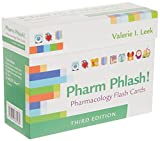
Focus on Pharmacology (8th Edition)
Focus on Nursing Pharmacology makes challenging concepts more approachable. Engaging learning features cultivate your clinical application, critical thinking and patient education capabilities. This updated 8th edition builds on your knowledge of physiology, chemistry and nursing fundamentals to help you conceptualize need-to-know information about each group of drugs.
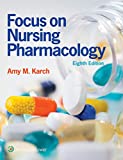
Pharmacology Made Incredibly Easy (Incredibly Easy! Series®)
Nursing pharmacology guide offers step-by-step guidance so you can grasp the fundamentals in enjoyable Incredibly Easy style. This is the perfect supplement to class materials, offering solid preparation for NCLEX® as well as a handy refresher for experienced nurses. Colorfully illustrated chapters offer clear, concise descriptions of crucial nursing pharmacology concepts and procedures.
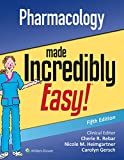
Lehne’s Pharmacology for Nursing Care (11th Edition)
The Eleventh Edition of Lehne’s Pharmacology for Nursing Care provides a thorough understanding of key drugs and their implications for nursing care. This text, written by renowned nursing educators, helps you comprehend and apply pharmacology principles. A clear and engaging writing style simplifies complex concepts, making even the most challenging pharmacology content enjoyable. We recommend this book if you want a comprehensive nursing pharmacology guide.
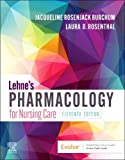
Nursing Drug Handbook
Nursing2023 Drug Handbook delivers evidence-based, nursing-focused drug monographs for nearly 3700 generic, brand-name, and combination drugs. With a tabbed, alphabetical organization and a “New Drugs” section, NDH2023 makes it easy to check drug facts on the spot.
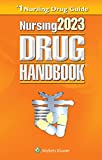
Pharmacology and the Nursing Process
The 10th edition of Pharmacology and the Nursing Process offers practical, user-friendly pharmacology information. The photo atlas contains over 100 unique illustrations and photographs depicting drug administration techniques. Updated drug content reflects the most recent FDA drug approvals, withdrawals, and therapeutic uses.
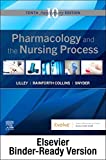
Mosby’s Pharmacology Memory NoteCards: Visual, Mnemonic, and Memory Aids for Nurses
The 6th edition of Mosby’s Pharmacology Memory NoteCards: Visual, Mnemonic, & Memory Aids for Nurses incorporates illustrations and humor to make studying easier and more enjoyable. This unique pharmacology review can be utilized as a spiral-bound notebook or as individual flashcards, making it ideal for mobile study.
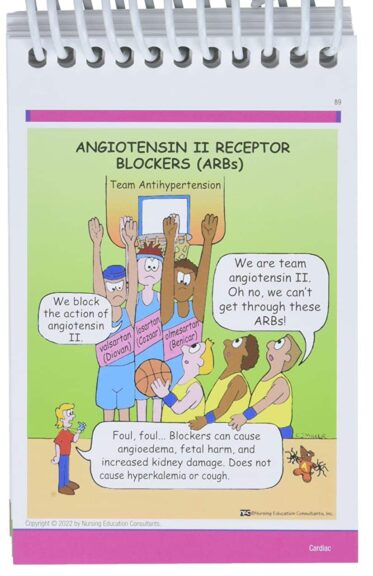
See Also
Here are other nursing pharmacology study guides:
- Nursing Pharmacology – Study Guide for Nurses
Our collection of topics related to nursing pharmacology - Pharmacology Nursing Mnemonics & Tips
These nursing mnemonics aim to simplify the concepts of pharmacology through the use of a simple, concise guide. - Generic Drug Name Stems Cheat Sheet
Learn about these generic drug name stems to help you make sense of drugs easier! - Common Drugs and Their Antidotes
A guide to drug antidotes that nurses should be familiar about. - IV Fluids and Solutions Guide & Cheat Sheet
Get to know the different types of intravenous solutions or IV fluids in this guide and cheat sheet. - Drug Dosage Calculations NCLEX Practice Questions (100+ Items)
Care to take the challenge? This quiz aims to help students and registered nurses alike grasp and master the concepts of medication calculation.
Drug Guides NEW!
Individual drug guides and nursing considerations for the most common medications used in nursing pharmacology:
- Acetaminophen (Tylenol)
- Aspirin
- Atorvastatin (Lipitor)
- Enoxaparin (Lovenox)
- Furosemide (Lasix)
- Gabapentin
- Hydromorphone (Dilaudid)
- Lisinopril
- Metoprolol
- Morphine
Gastrointestinal System Drugs
Respiratory System Drugs
- Antihistamines
- Bronchodilators and Antiasthmatics
- Decongestants
- Expectorants and Mucolytics
- Inhaled Steroids
- Lung Surfactants
Endocrine System Drugs
- Adrenocortical Agents
- Antidiabetic Agents
- Glucose-Elevating Agents
- Hypothalamic Agents
- Insulin
- Parathyroid Agents: Bisphosphonates, Calcitonins
- Pituitary Drugs
- Sulfonylureas
- Thyroid Agents
Autonomic Nervous System Drugs
- Adrenergic Agonists (Sympathomimetics)
- Adrenergic Antagonists (Sympatholytics)
- Anticholinergics (Parasympatholytics)
- Cholinergic Agonists (Parasympathomimetics)
Immune System Drugs
Chemotherapeutic Agents
- Anthelmintics
- Anti-Infective Drugs
- Antibiotics
- Antifungals
- Antineoplastic Agents
- Antiprotozoal Drugs
- Antiviral Drugs
Reproductive System Drugs
Nervous System Drugs
- Antidepressants
- Antiparkinsonism Drugs
- Antiseizure Drugs
- Anxiolytics and Hypnotic Drugs
- General and Local Anesthetics
- Muscle Relaxants
- Narcotics, Narcotic Agonists, and Antimigraine Agents
- Neuromuscular Junction Blocking Agents
- Psychotherapeutic Drugs
Cardiovascular System Drugs
References and Sources
References and sources for this pharmacology guide for Antidiabetic Agents:
- Karch, A. M., & Karch. (2011). Focus on nursing pharmacology. Wolters Kluwer Health/Lippincott Williams & Wilkins. [Link]
- Katzung, B. G. (2017). Basic and clinical pharmacology. McGraw-Hill Education.
- Lehne, R. A., Moore, L. A., Crosby, L. J., & Hamilton, D. B. (2004). Pharmacology for nursing care.
- Smeltzer, S. C., & Bare, B. G. (1992). Brunner & Suddarth’s textbook of medical-surgical nursing. Philadelphia: JB Lippincott.
